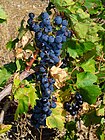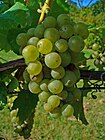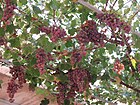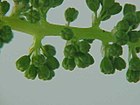Note: This is a project under development. The articles on this wiki are just being initiated and broadly incomplete. You can Help creating new pages.
Vitis vinifera - Draksha, Grape
Vitis vinifera is a fruit, botanically a berry, of the deciduous woody vines of the flowering plant genus Vitis.Grapes can be eaten fresh as table grapes or they can be used for making wine, jam, juice, jelly, grape seed extract, raisins, vinegar, and grape seed oil. Grapes are a non-climacteric type of fruit, generally occurring in clusters.
Contents
- 1 Uses
- 2 Parts Used
- 3 Chemical Composition
- 4 Common names
- 5 Properties
- 6 Habit
- 7 Identification
- 8 List of Ayurvedic medicine in which the herb is used
- 9 Where to get the saplings
- 10 Mode of Propagation
- 11 How to plant/cultivate
- 12 Commonly seen growing in areas
- 13 Photo Gallery
- 14 References
- 15 External Links
Uses
varicose veins, Hemorrhoids, Constipation, Cough, Attention deficit-hyperactivity disorder, Heavy menstrual periods, Canker sores, Diarrhea, Liver damage
Parts Used
Chemical Composition
Mencía samples were analysed for phenolic, (flavan-3-ols, flavonols, anthocyanins, acids and resveratrol), nitrogen (TAC, TAN, YAN and TAS) and volatiles compounds (alcohols, C6 compounds, ethyl esters, terpenes, aldehydes, acids, lactones, volatile phenols and carbonyl compounds) by GC-MS and HPLC[1]
Common names
| Language | Common name |
|---|---|
| Kannada | |
| Hindi | |
| Malayalam | |
| Tamil | |
| Telugu | |
| Marathi | NA |
| Gujarathi | NA |
| Punjabi | NA |
| Kashmiri | NA |
| Sanskrit | |
| English | Grape Vine |
Properties
Reference: Dravya - Substance, Rasa - Taste, Guna - Qualities, Veerya - Potency, Vipaka - Post-digesion effect, Karma - Pharmacological activity, Prabhava - Therepeutics.
Dravya
Rasa
Madhura (sweet)
Guna
Guru (heavy), Snigda (Unctous)
Veerya
Sheeta (cold)
Vipaka
Madhura (sweet)
Karma
Pitta, Vata
Prabhava
Habit
Identification
Leaf
| Kind | Shape | Feature |
|---|---|---|
| Simple | orbicular | The leaves are Pentagonal or dissected, 10.5-20 x 7-15 cm, serrate or irregularly |
Flower
| Type | Size | Color and composition | Stamen | More information |
|---|---|---|---|---|
| Bisexual | 2 mm long | greenish | 5-20 | Flowers Season is June - August |
Fruit
| Type | Size | Mass | Appearance | Seeds | More information |
|---|---|---|---|---|---|
| Berry | 6-22 mm long | With juicy sweet or sour pulp | With hooked hairs | 2-4 seeded | {{{6}}} |
Other features
List of Ayurvedic medicine in which the herb is used
- Vishatinduka Taila as root juice extract
Where to get the saplings
Mode of Propagation
How to plant/cultivate
Landscape Uses:Arbor. Prefers a deep rich moist well-drained moderately fertile loam[1, 200]. Grows best in a calcareous soil, but dislikes excessively chalky soils[3]
Commonly seen growing in areas
Riversides and damp woods, Grows on the banks of the Thames.
Photo Gallery
References
External Links
- Ayurvedic Herbs known to be helpful to treat varicose veins
- Ayurvedic Herbs known to be helpful to treat Hemorrhoids
- Ayurvedic Herbs known to be helpful to treat Constipation
- Ayurvedic Herbs known to be helpful to treat Cough
- Ayurvedic Herbs known to be helpful to treat Attention deficit-hyperactivity disorder
- Ayurvedic Herbs known to be helpful to treat Heavy menstrual periods
- Ayurvedic Herbs known to be helpful to treat Canker sores
- Ayurvedic Herbs known to be helpful to treat Diarrhea
- Ayurvedic Herbs known to be helpful to treat Liver damage
- Herbs with Flowers used in medicine
- Herbs with Fruits used in medicine
- Herbs with Leaves used in medicine
- Herbs with common name in English
- Habit - large shrub
- Index of Plants which can be propagated by Seeds
- Index of Plants which can be propagated by Cuttings
- Herbs that are commonly seen in the region of Riversides and damp woods
- Herbs that are commonly seen in the region of Grows on the banks of the Thames
- Herbs







